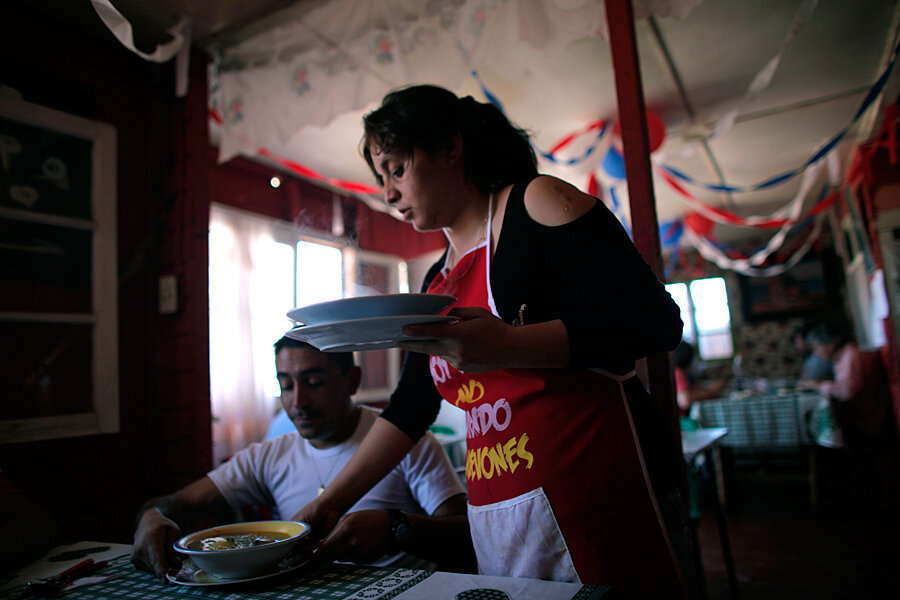Label it: Chile battles obesity
Loading...
| Santiago, Chile
Change is coming to the Chilean lunch box. After years of ever sweeter, fattier, and saltier snacks, new rules aim to move children's diets toward healthier foods.
The guidelines, published late last month, will require some of the most popular kids’ foods to carry a warning label. Starting this year, packaged foods and soft drinks high in saturated fat, sugar, or salt will carry prominent markers on the front of the package.
These will be the world’s first obligatory warnings for such ingredients, says Undersecretary of Health Jorge Díaz.
Chile is responding to a swelling obesity rate and a widespread lack of consumer consciousness. Chileans are moving to cities, buying more processed food, and leading more sedentary lives, the health ministry says. Now, the long-thin country has swelled to be the sixth most obese among the 39 wealthy nations in the Organization for Economic Cooperation and Development. A quarter of Chileans are listed as obese, and obesity in children six years old and under rose from 7.2 percent in 2005 to 10.1 percent in 2012, according to Mr. Díaz.
“This is absolutely astounding,” says Marion Nestle, a professor of food policy at New York University who has pushed for similar labels in the US and is impressed by the rules. “I’ve never seen anything like this before.”
The labels will do more than educate buyers. Under a law passed in 2012, foods bearing the warnings will be prohibited from sale at elementary and high schools. It will be illegal for foodmakers to market such products to children. Manufacturers will also be prohibited from using toys and stickers to sell the designated products.
While Dr. Nestle was impressed by the labels, they have been toned down compared to the government’s initial proposal. A draft filed with the World Trade Organization a year ago would have required labels on any milk, meat, cheese, or fish that was high in salt, sugar, or saturated fat. The labels would have been black or red octagons taking up a fifth of the package surface.
Those products were all exempted from the final rule. The reasoning, Díaz says, is that the ministry wanted to start with foods primarily eaten by children such as flavored milk, yogurt, breakfast cereal, condiments, and soft drinks.
In addition, the look of the label was softened. Despite a study that found that a big octagon – the shape of a stop sign – was the most effective symbol for changing consumer behavior, the government labels will be smaller hexagons.
The modest number of products covered and the changes to the labels have angered some, including Sen. Guido Girardi. He calls the new rule “rubbish,” and says he’ll ask incoming President Michelle Bachelet to start the process from scratch. Sen. Girardi says the rules should cover all food, including that served in restaurants.
“This doesn’t cover Kentucky Fried Chicken or any other fast food,” Girardi says.
Foodmakers can also pick among red, blue, or green labels, which frustrates the senator. A green label saying a product is high in sugar could appear to be a positive message, especially for consumers who don’t read well.
Díaz, the undersecretary of health, says the measures are a first important step. The rules had to start slowly so as not to violate Chile’s obligations under free trade treaties, he says.
Six months from now, the ministry can adjust the rules, he says. “Officials can say you know what, we weren’t very rigorous with fat levels. Let’s put it a bit lower.”
In addition, Díaz says that food companies are already shifting their mix of products. Of the 1,310 packaged foods available in Chilean supermarkets, 24 percent would get a label if the fat, sugar, and salt standards were all imposed today, according to a Health Ministry study. Soft drink makers have already started to roll out new lines of low-calorie drinks, and Díaz says he expects that only 20 percent of products will end up being labeled.
Ricardo Uauy, a University of Chile nutrition scientist, takes the long view, noting that the country’s label debate has already gone on for more than a decade. “It’s not satisfactory,” Mr. Uauy says. “But I’m optimistic. We shall overcome.”







